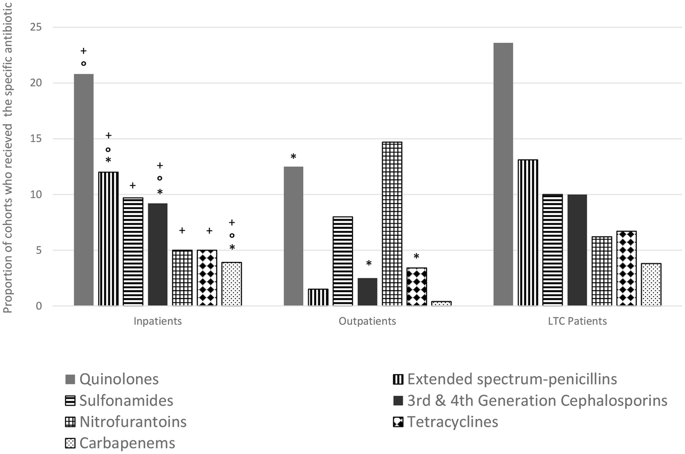当前位置:
X-MOL 学术
›
Spinal Cord
›
论文详情
Our official English website, www.x-mol.net, welcomes your
feedback! (Note: you will need to create a separate account there.)
Multidrug-resistant gram-negative organisms and association with 1-year mortality, readmission, and length of stay in Veterans with spinal cord injuries and disorders.
Spinal Cord ( IF 2.1 ) Pub Date : 2019-12-11 , DOI: 10.1038/s41393-019-0393-y Swetha Ramanathan 1 , Margaret A Fitzpatrick 1, 2 , Katie J Suda 3, 4 , Stephen P Burns 5, 6 , Makoto M Jones 7, 8 , Sherri L LaVela 1, 9 , Charlesnika T Evans 1, 10
Spinal Cord ( IF 2.1 ) Pub Date : 2019-12-11 , DOI: 10.1038/s41393-019-0393-y Swetha Ramanathan 1 , Margaret A Fitzpatrick 1, 2 , Katie J Suda 3, 4 , Stephen P Burns 5, 6 , Makoto M Jones 7, 8 , Sherri L LaVela 1, 9 , Charlesnika T Evans 1, 10
Affiliation

|
STUDY DESIGN
Retrospective cohort study.
OBJECTIVES
The goal of this study was to assess the impact of multidrug resistant gram-negative organisms (MDRGNOs) on outcomes in those with SCI/D.
SETTING
VA SCI System of Care, Department of Veterans Affairs, United States.
METHODS
Multidrug resistance (MDR) was defined as being non-susceptible to ≥1 antibiotic in ≥3 antibiotic classes. Multivariable cluster-adjusted regression models were fit to assess the association of MDRGNOs with 1-year mortality, 30-day readmission, and postculture length of stay (LOS) stratified by case setting patients. Only the first culture per patient during the study period was included.
RESULTS
A total of 8,681 individuals with SCI/D had a culture with gram-negative bacteria during the study period, of which 33.0% had a MDRGNO. Overall, 954 (10.9%) died within 1 year of culture date. Poisson regression showed that MDR was associated with 1-year mortality among outpatients (IRR: 1.28, 95% CI, 1.06-1.54) and long-term care patients (OR: 2.06, 95% CI, 1.28-3.31). MDR significantly impacted postculture LOS in inpatients, as evidenced by a 10% longer LOS in MDR vs. non-MDR (IRR: 1.10, 95% CI, 1.02-1.19). MDR was not associated with increased 30-day readmission.
CONCLUSIONS
MDRGNOs are prevalent in SCI/D and MDR may result in poor outcomes. Further attention to prevention of infections, antibiotic stewardship, and management are warranted in this population.
中文翻译:

多重耐药革兰氏阴性菌与患有脊髓损伤和疾病的退伍军人的 1 年死亡率、再入院率和住院时间的关系。
研究设计回顾性队列研究。目的 本研究的目的是评估多重耐药革兰氏阴性菌 (MDRGNO) 对 SCI/D 患者预后的影响。设置 VA SCI 护理系统,美国退伍军人事务部。方法 多药耐药性 (MDR) 定义为对 ≥3 类抗生素中的 ≥1 种抗生素不敏感。多变量聚类调整回归模型适合评估 MDRGNO 与 1 年死亡率、30 天再入院和按病例患者分层的培养后住院时间 (LOS) 的关联。仅包括研究期间每个患者的第一次培养。结果 研究期间共有 8,681 名 SCI/D 患者进行了革兰氏阴性菌培养,其中 33.0% 患有 MDRGNO。总体而言,954 例 (10.9%) 在培养后 1 年内死亡。泊松回归显示,MDR 与门诊患者(IRR:1.28,95% CI,1.06-1.54)和长期护理患者(OR:2.06,95% CI,1.28-3.31)的 1 年死亡率相关。MDR 显着影响住院患者的培养后 LOS,MDR 患者的 LOS 比非 MDR 患者的 LOS 长 10%(IRR:1.10,95% CI,1.02-1.19)。MDR 与 30 天再入院率增加无关。结论 MDRGNO 在 SCI/D 中普遍存在,而 MDR 可能会导致不良结果。需要进一步关注这一人群的感染预防、抗生素管理和管理。
更新日期:2019-12-11
中文翻译:

多重耐药革兰氏阴性菌与患有脊髓损伤和疾病的退伍军人的 1 年死亡率、再入院率和住院时间的关系。
研究设计回顾性队列研究。目的 本研究的目的是评估多重耐药革兰氏阴性菌 (MDRGNO) 对 SCI/D 患者预后的影响。设置 VA SCI 护理系统,美国退伍军人事务部。方法 多药耐药性 (MDR) 定义为对 ≥3 类抗生素中的 ≥1 种抗生素不敏感。多变量聚类调整回归模型适合评估 MDRGNO 与 1 年死亡率、30 天再入院和按病例患者分层的培养后住院时间 (LOS) 的关联。仅包括研究期间每个患者的第一次培养。结果 研究期间共有 8,681 名 SCI/D 患者进行了革兰氏阴性菌培养,其中 33.0% 患有 MDRGNO。总体而言,954 例 (10.9%) 在培养后 1 年内死亡。泊松回归显示,MDR 与门诊患者(IRR:1.28,95% CI,1.06-1.54)和长期护理患者(OR:2.06,95% CI,1.28-3.31)的 1 年死亡率相关。MDR 显着影响住院患者的培养后 LOS,MDR 患者的 LOS 比非 MDR 患者的 LOS 长 10%(IRR:1.10,95% CI,1.02-1.19)。MDR 与 30 天再入院率增加无关。结论 MDRGNO 在 SCI/D 中普遍存在,而 MDR 可能会导致不良结果。需要进一步关注这一人群的感染预防、抗生素管理和管理。











































 京公网安备 11010802027423号
京公网安备 11010802027423号